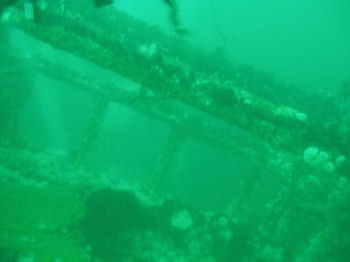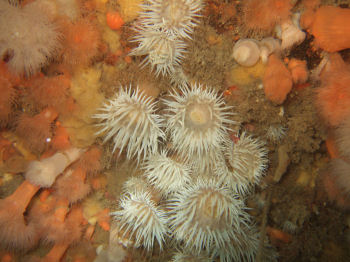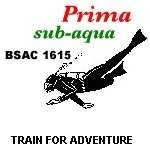
Issue 8 July 2007
Off-Gassing...
(Web Version)
Welcome to the
eighth issue of our newsletter.
Congratulations to Sue & John who were married on Saturday 7th July 2007
and are at present on honeymoon in the Lake District.
Profile:- Richard Mace - Equipment Officer
Welcome to a new member Christopher Andrews who joined the club this month.
--------------------------------------
Congratulations to :-
Scott Leighton and Alex Stirk who are now both Ocean Divers
Michael Alkiviadou and Sophie Russell who are now both Dive Leaders.
-----------------------------------------
Fay Noakes who has returned from Arizona with her wings.
It started with Hans & Lotte Hass and Sea Hunt
with Lloyd Bridges. For the information of our younger readers, these
were 50s/60s television programs. I always had a fascination with the
under-water world. I did, however, have a major difficulty in pursuing
my interest. I couldn’t swim for toffee. Much later (well into my 40’s)
I started to go the baths in my lunch hour and managed to do 80 lengths
for a BT ‘Swimathon’. It must be around 17 years ago when I did my first
‘try-dive’ with Prima. I remember Lin and Al being there. Sue and I had
a young family at the time so I didn’t take things any further. Around
six years ago Sue and I found ourselves on a PADI Open Water course in
Koh Samui, Thailand. The plan, at that time, was to just dive while on
holiday abroad and nothing was further from my mind than diving in the
gloomy British sea or among “shopping trolleys & stolen cars” in
quarries.
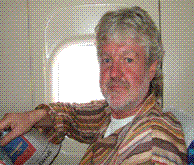 Sue
didn’t manage to complete the course in Thailand so we decided to join a
club on our return. For the first few months while Sue was doing her
Ocean Diver I didn’t dive because “I can dive can’t I?”. I remember
floundering around during my first ‘dry’ suit dive at Criccieth. Al
really has incredible patience! I suppose it was everyone’s enthusiasm
that got me into the water so much. Perhaps my most memorable dive was
at Blithfield Reservoir, New Year’s Day 2004. I remember clambering down
the bridge embankment with my 15l cylinder on my back (it didn’t occur
to me that a 10l may be more appropriate). It was snowing and I was
still under the effects of the previous night’s excesses. The surface
temperature was 3 deg. and the water was like porridge, Al’s torch
looking like a fag-end. We only managed 11 minutes because I had an
uncontrolled ascent (no change there!). What a dive, still, we did
manage to go to the pub afterwards!
Sue
didn’t manage to complete the course in Thailand so we decided to join a
club on our return. For the first few months while Sue was doing her
Ocean Diver I didn’t dive because “I can dive can’t I?”. I remember
floundering around during my first ‘dry’ suit dive at Criccieth. Al
really has incredible patience! I suppose it was everyone’s enthusiasm
that got me into the water so much. Perhaps my most memorable dive was
at Blithfield Reservoir, New Year’s Day 2004. I remember clambering down
the bridge embankment with my 15l cylinder on my back (it didn’t occur
to me that a 10l may be more appropriate). It was snowing and I was
still under the effects of the previous night’s excesses. The surface
temperature was 3 deg. and the water was like porridge, Al’s torch
looking like a fag-end. We only managed 11 minutes because I had an
uncontrolled ascent (no change there!). What a dive, still, we did
manage to go to the pub afterwards!
I want to take this opportunity to thank everyone who has helped Sue and
I over the years, you really are a great bunch of people. To quote
someone or other “Probably the best dive club in the world”.
PS – I still can’t swim for toffee……
Seasearch Course - Swanage
10 litre Cylinder. In test
£50 contact: Richard Mace
0121 232 6007
If you have any items for sale please let us know.
Nine of us attended the
course at Swanage, covering the ways to identify the different flora and
fauna found lurking the depths. Things you would initially think were
plants turn out to be animals. Sponges are in fact animal with extremely
variable body forms and sizes. The afternoon was spent looking intently
at very small things which had been collected from under Swanage pier.
Items such as sea spiders, shrimps, slipper limpets, mussels and various
worms.
On Sunday some of us dived under the pier and a few others went off to
Portland Bill to dive the Siddon Sub Marine. 35m to the sea bed. Viz was
not so good but the conger eel free swimming around the conning tower
was a lovely sight. Back at Swanage those diving under the pier decided
to try out the new found skills, armed with a large sketch pad set about
sketching fish and recording other things to be found such as green
fuzzy thing, brown squashy thing and the like ( Obviously not all the
knowledge was absorbed totally.
I think a good weekend was had by all who attended and we did learn some
things, so the next time we all dive we will be aware of a lot more.
Harbour Crab:- Liocarcinus depurator
Editors Corner
Thank you to everyone who has contributed to this months issue, and apologies for any mistakes.
Any further articles for next months edition would be appreciated, (any gossip, scandals, etc that’s printable) so let us know by 20th July.
Hope you enjoyed this issue.
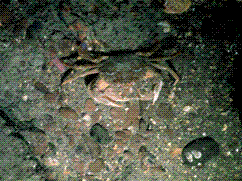
The harbour crab is usually found in sandy areas, and not just within harbours. There are a number of other similar swimming crabs which are difficult to tell apart.
It is found all around the British Isles to depths of 25metres. It is slightly smaller the a mans hand.
Wreck of the Month - The Hispania
The Hispania was built in 1912 in Belgium and traded for 32 years until 1954. Whilst passing up the west coast of Scotland on a voyage from Liverpool to Gothenburg she attempted to navigate through the narrow stretch of treacherous water that separates the island of Mull from the mainland, the Sound of Mull. A fierce winter storm of driving wind, rain and sleet had reduced visibility practically to nil and in these atrocious conditions she ran onto a notorious reef, the Sgeir More or Big Rock where she stuck fast.
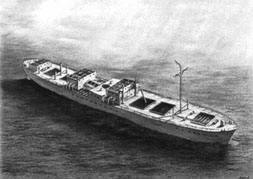
Her engines were put astern and as she came off the Rock she immediately started listing to port. It soon became clear that she was going to sink. The order was given to abandon ship and the crew lowered and lifeboats and all safely got aboard.
The Captain however refused to leave the vessel. For an hour the crew rowed round the stricken vessel calling out for the Captain to abandon ship. He steadfastly refused to do so and as the Hispania sunk beneath the waves he was last seen standing in the bridge, his hand raised to his forehead in a salute. The crew were all able to safely row ashore.
Today, she lies upright with a slight starboard list in 26 metres of crystal clear water. She is structurally intact despite her long years on the bottom and is covered with thick and colourful sponges, anemones and dead men's fingers.
The history, sinking and dive details of the Hispania are described in much greater detail in the book Dive Scotland's Greatest Shipwrecks.
